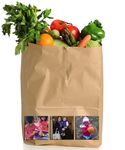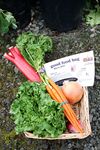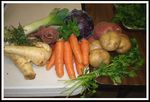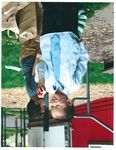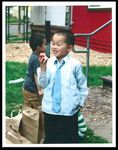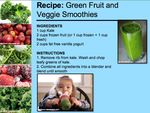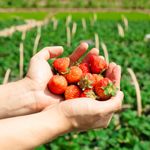The Good Food Bag Toolkit - Lessons Learned From a Farm to Preschool Pilot Program-and How to Apply Them in Your own Community
←
→
Page content transcription
If your browser does not render page correctly, please read the page content below
The Good
Food Bag
Toolkit
Lessons Learned From a
Farm to Preschool Pilot Program—and
How to Apply Them in Your own Community
THE FARM TO TABLE PARTNERSHIP
November 2014Acknowledgements
The Farm to Table Partnership’s Good Food Bag Toolkit reflects the combined efforts and
commitment of many individuals and organizations. It was made possible, in part, with funding from
the Centers for Disease Control and Prevention in partnership with Seattle Children’s Hospital, Public
Health—Seattle & King County, and the Healthy King County Coalition.
Author
Janet Epstein
Design & Layout
Irene Stewart
Reviewers
Valerie Baldisserotto Elizabeth Kimball Angela Miyamoto
Jess Bitting Maria Langlais Tiffany Ngo
Sharon Bogan Sharon Lerman Lucy Norris
Tara Bostock Karen Mauden Natalie Thomson
Adrienne Dorf
Special thanks go to the Seattle-based child care agencies who participated in the Good Food Bag
Pilot and who generously shared their wisdom and experience:
Educare School of Greater Seattle
Refugee & Immigrant Family Center
Tiny Tots Development Center
Further information
For more information about the Seattle Good Food Bag Pilot and the Farm to Table Program, contact
Natalie Thomson, City of Seattle Human Services Department, Youth and Family Empowerment
Division (206-684-0840 or Natalie.Thomson@seattle.gov).
Think local
The recommendations and models described in the Good Food Bag Toolkit are based on local
experiences and regulations governing food safety, philanthropy, and contractual commitments.
Consult with your local public health department or other applicable public agencies when
developing programs in your community.
Copies
Download this publication at www.agingkingcounty.org/FarmToTable/.The Good Food Bag Toolkit
Table of Contents
Preface......................................................................................................................................... 5X
I. Roots & Seeds: Laying the Groundwork
Roots of the Farm to Table and Good Food Bag (GFB) Programs .............................. 9X
Fresh is Best...................................................................................................................10
The Social, Family, and Research Context ...................................................................11
II. Cultivation: Developing the Pilots
How the Good Food Bag Pilot Worked ..........................................................................13
Three Pilot GFB Child Care Sites ...................................................................................14
• Educare
• Tiny Tots
• Refugee and Immigrant Family Center
Universal Themes and Takeaways ...............................................................................20
III. Harvest: Starting a Good Food Bag Program
How to Start a GFB Program in Your Community .........................................................28
Trends and Opportunities ..............................................................................................36
Appendices
Appendix A: References & Resources ......................................................................................38
Appendix B: Research and Evaluation Note ..............................................................................41
Appendix C: Details on the Good Food Bag Pilots.....................................................................42
• Educare
• Tiny Tots
• Refugee and Immigrant Family CenterPreface
Good Food Bags contain fresh produce, recipes, and tips to make it easier for lower-income
young children and their families, of all backgrounds, to enjoy fresh fruits and vegetables. The
low-cost bags are distributed through community organizations.
Our Good Food Bag Pilot Program was part of a multipronged A Tale of
strategy to:
Green
Increase access to fresh, seasonal produce. Smoothies,
Gardens,
Set the stage for lifelong healthier food choices among
lower-income preschool-aged children and their families. and Good
Food Bags
Improve health and reduce the incidence of diet-related
diseases. To ramp up interest in farm-
fresh produce, a Good Food
Empower communities by supporting local farmers and the Bag program coordinator
local economy. blended green smoothies for
tasting during an outreach
The Toolkit is based on the experiences of three Seattle, visit. The kids loved the green
Washington-based child care agencies serving vulnerable families,
concoction … despite
with input from nonprofit and government agency partners.
witnessing the addition of
kale and spinach to the mix.
Who is this Toolkit for?
Later, one of the mothers was
The Toolkit is geared to staff of child care agencies—from meal
coordinators, nutrition aides, and managers to teachers, fiscal considering whether the $5
personnel, and volunteers. It may also be relevant to faith-based Good Food Bag was too much
organizations, family centers, subsidized housing communities, on her limited budget. During
and other community-based groups that work with underserved a neighborhood stroll with her
groups. daughter, she experienced an
“aha” moment.
We provide nuts and bolts tips gleaned from our early review of
pioneering programs in Canada and our own local experiences. We Mother and child came upon
hope this Toolkit will help your agency think about whether or not a a kale plant in a neighbor’s
Good Food Bag program is feasible, and shed light on core garden. “Mom, can we make
questions such as: smoothies!?” At that moment,
the mother knew she had to
Is my agency poised to launch a GFB program?
keep purchasing the weekly
What are the core concepts, competencies, and program bag for her family.
components? This is one of many teachable
moments from the 2013
What were the “success factors” in the Seattle-area pilot
Good Food Bag Pilot Project
that might inform the design of a program in my city?
in the Pacific Northwest.
What challenges and opportunities emerged from the
Seattle experience?
The Good Food Bag Toolkit • Page 5Our purpose in writing this Toolkit is to provide accessible, hands-on information to support others
who want to create a similar program in their own communities.
How to use the Toolkit
Many readers will first review the “how-to” content, later returning to other sections. Others will want
background information before jumping into hands-on activities or takeaways. Feel free to explore
the document, as the spirit moves, perhaps using the search function for specific content.
The Toolkit is divided into three sections:
I. Roots & Seeds: Laying The Groundwork gives perspective on the
genesis of the pilot including local food system policy and funding—
with a nod to the family support, development, and health contexts in
which a child care-sited Good Food Bag program takes place.
II. Cultivation: Developing the Pilots summarizes the experiences of
three child care centers that developed a Good Food Bag Program
and highlights common themes that emerged from the collective
experience of the Farm to Table Partnership.
III. Harvest: Starting a Good Food Bag Program gets down to the nitty-
gritty, exploring the experiences of each child care agency,
highlighting key takeaway points. Glean tips for assessing capacity to
develop a GFB program in your area and implementation pointers.
Throughout the document, you’ll find hyperlinks to relevant websites, samples of forms, and
marketing materials to inspire you. Finer details of the program elements and lessons learned from
each child care agency are in Appendix C.
Frequently used acronyms and terms
Certain terms and abbreviations appear repeatedly throughout the document:
Farm to Table—a A regional food hub is “a
Food
F2T community partnership to
Hub
business or organization
bring affordable fresh local that actively manages the
produce to children in Seattle and King aggregation, distribution, and marketing of
County to reduce health disparities; improve source-identified food products primarily
nutritional status and food security; from local and regional producers to
strengthen the local economy through job strengthen their ability to satisfy wholesale,
creation and support of local farmers; and retail, and institutional demand” (working
build community. The Good Food Bag Pilot definition used by U.S. Department of
grew out of the Farm to Table Partnership. Agriculture).
Additional abbreviations:
CDC—Centers for Disease Control and EBT—Electronic Benefits Transfer
Prevention SNAP—Supplemental Nutrition Assistance
CSA—Community Supported Agriculture Program, formerly known as “food stamps”
The Good Food Bag Toolkit • Page 6Updates and opportunities since the GFB pilot
Since the close of the Good Food Bag pilot, interest in developing more GFB programs locally has
skyrocketed. Two of the three child care agency pilots are continuing their programs. And, as of fall
2014, over 20 groups are planning or have already started a program of their own.
Changes in federal law enhance access to fresh produce. More flexible options are available for use
of electronic benefits transfer (EBT) cards held by Supplemental Nutrition Assistance Program
(SNAP) enrollees. For example, these can now be used at approved farmers markets. Locally, one of
the child care agencies that participated in the GFB pilot is testing the use of an EBT point of sale
device on site.
And since June 2014, the amount available for purchase of fresh fruits and vegetables by low-
income women enrolled in the federal Special Supplemental Nutrition Program for Women, Infants,
and Children (WIC) program has increased by 30 percent.
We hope that similar momentum and excitement about increasing food access, supporting
vulnerable children and families, and all the other benefits of a Good Food Bag program will take
hold in other communities.
Sample Flyer from a Good Food Bag Child Care Agency Pilot Site
The Good Food Bag Toolkit • Page 7Section I
Roots & Seeds:
Laying the Groundwork
Sufficient access to fresh fruits and vegetables is an
enduring dilemma in our country. One barrier is affordability.
The lack of nearby full-service grocery stores—known as
“food deserts”—is another.
According to an analysis of a large nationwide household survey, access to fresh, affordable produce
deeply affects lower-income households—especially those with children. Black and Hispanic
households, in particular, face an uphill climb.
Among households with children, at least 10 percent of survey respondents in 21 states said it was
hard to get affordable fresh fruits and vegetables. And while the numbers vary from place to place,
no part of the country is untouched by this problem. Programs and policies to address these barriers
are essential. But the survey analysts emphasize that an even greater push is needed to increase
the ability of families to purchase healthier foods through expansion of federal programs, such as
SNAP and WIC.
In June 2014, the WIC program increased the dollar amount available to recipients for purchasing
fresh fruits and vegetables. And more and more farmers markets around the country are exercising
the option to install EBT technology for use by SNAP recipients. Improving access in these ways to
fruits and vegetables ties to another key survey finding: those with the greatest difficulty accessing
fresh produce reported the worse health status, including obesity.
Media coverage of America’s obesity epidemic—and the corresponding increase in the number of
children who are overweight and obese—has captured the public eye. Extra weight and obesity in
childhood increases the likelihood of early onset diabetes and
other chronic conditions in adulthood—and social stigma
throughout life.
Private and public agencies have honed their sights on the
problem. The federal government increased commitments to
states and cities through such agencies as the U.S.
Department of Agriculture (USDA) and the Centers for Disease
Control and Prevention (CDC).
Some observers believe that efforts to reverse the childhood
obesity trend is yielding measurable results, particularly in
preschool-aged children—the focus of this Toolkit. The
research findings, however, are inconclusive and subject to
varying interpretation, depending on the timeframe studied
and other factors.
The Good Food Bag Toolkit • Roots & Seeds: Laying the Groundwork • Page 8Overall data can look promising, but progress Food Security
may be muted or even stagnant when studying When “all people at all times have access
subgroups such as people of color or those to sufficient, safe, nutritional food to maintain
living in poverty. For example, a CDC study a healthy and active life”
looking at an eight-year period showed obesity
reduction in school-aged children in places like Food security is a complex concept that is linked to
Anchorage, Philadelphia, New York City, and social, environmental, & economic development.
King County, Washington. In other states,
obesity rates actually increased. Core Elements
• Enough food is consistently available.
• Individuals & families have the resources to get
Ultimately we need to sustain and build on sufficient food for good nutrition.
positive trends and implement targeted • The use of food shows a basic understanding of
programs for those groups most deeply nutrition and related factors such as sanitation and
affected by poverty and food insecurity. enough water.
Progress in reducing overweight and obesity is
uneven across the country and inequities Adapted from proceedings of the World Food
Organization’s (WFO) World Food Summit of 1996
persist.
Roots of the Farm to Table and Good Food Bag Programs
While efforts to address childhood obesity have been underway for
years in the Pacific Northwest (Seattle–King County in Western
Washington), the year 2010 marked a turning point. That year,
commitment became more strategic and comprehensive.
Several groups got together to develop new ways to educate and
engage individuals, forge new partnerships with a range of groups—
including small farms—and apply a unique approach to providing fresh,
locally sourced produce to:
Children and families at child care agencies.
Seniors at nonprofit agencies where older adults gather to share Farm to Table (F2T): A federally
meals and enjoy daily activities. funded program that connects
City of Seattle-supported
preschool, child care, and
The City of Seattle Human Services Department received CDC funding senior meal sites with
local farmers.
awarded by our local health department, Public Health—Seattle & King
County. The Farm to Table (F2T) Partnership in Seattle and King County
used the grant to enhance nutrition and food access.
F2T was implemented by two divisions of the City of Seattle Human Services Department that
contract with group meal sites for older adults and licensed early learning–child care agencies for a
variety of services.
In addition to continuing to ensure basic federal nutrition standards were
met in child care settings, federal funding allowed the City of Seattle to add
healthier foods to the usual fare, assist in food preparation, promote
healthy eating, and develop relationships with local farms.
The Good Food Bag Toolkit • Roots & Seeds: Laying the Groundwork • Page 9Fresh is best
The F2T Program increased access to fresh, local produce to low-
income children and older adults by linking City-supported licensed
child care agencies and senior meal programs to local farmers through
a mix of purchasing and distribution models.
Online ordering for direct delivery via a Farm to Table store.
Purchasing directly from a farm or through a food hub.
Subscribing to a Community Supported Agriculture (CSA)
program by prepaying for farm-fresh produce and picking it up
at a designated time and location.
A second CDC-funded grant was awarded to the City in 2012 by Seattle Seattle Food Policy
Children’s—the premier regional children’s hospital. This additional
Milestones
funding—along with dedicated funds and in-kind support from the City
of Seattle—enabled the F2T Program to expand and continue obesity 2008 Seattle City Council
prevention activities by increasing access to fresh produce. passes an initiative to
improve the local and
regional food system
A perennial F2T theme is the reduction of 2009 Food
health disparities. interdepartmental
team created to
coordinate work in
Fertile Policy Environment and Commitment to cross-cutting programs
across City
Reducing Inequities government
The success of F2T and similar programs hinged, in part, on a 2012 First City food policy
supportive policy climate that raised obesity, economic development, advisor guides
food access, and sustainability issues to the forefront in local community outreach
to set priorities, from
government. improving access to
healthy food for all to
The F2T Program aligned with City of Seattle policy to increase access supporting the local
economy and “growing
to affordable, local, healthy, sustainable, and culturally appropriate local.”
food in preschool, child care, and senior meal sites where Seattle and
City embeds food
King County’s most underserved residents gather. The program policy into
targeted geographic areas where agencies serve a highly diverse comprehensive
population. planning, revealing
links between food
systems and land use,
Sustainability refers to policies and behaviors that transportation,
reduce the rate of depletion of environmental, housing, economic
development, the
economic, and social resources. environment, and
human development
Key factors contributing to success were a positive relationship and well-being.
between the City and the health department, a commitment to 2013 Nutrition and physical
engaging the local community in developing and implementing activity best practices
programs, and an explicit acknowledgement of the disparate impact of added to City contracts
with several licensed
food inequities on communities of color, low-income citizens, children, preschools.
and older adults.
The Good Food Bag Toolkit • Roots & Seeds: Laying the Groundwork • Page 10Positive political will, along with rich agricultural resources in the region and a history of urban
gardening, boosted the success and expansion of the F2T Program and its offspring, the Good Food
Bag Pilot.
The Social, Family, and Research Contexts
Targeting preschool-aged children
Although the obesity epidemic among young children is beginning to plateau
in a few cities, the overall numbers argue for continued efforts to safeguard
and support preschool-aged children.
According to the Institute of Medicine (IOM), 21.2 percent of children aged
2–5 in the United States are overweight or obese. The IOM notes that diets
rich in fruits and vegetables are one avenue to potentially reduce the likelihood of child overweight
and obesity. Nipping overweight and obesity in the bud is important because this weight pattern in
young children tends to persist into adulthood.
Maximizing child health is just one element in laying the foundation for achieving the best in family
well-being. The principles of family support and childhood development place a priority on:
A big picture lens to build a strong foundation for parents and children.
Prevention-focused programs that are integrated, community-based, and consider both the
needs and assets of parents.
Basic needs such as food, housing, health care, and education.
Families as partners to drive programs and services.
Culturally and linguistically responsive framework to guide decisions and programs.
Encouraging healthy eating habits with children early in life can instill good choices and cement
behaviors that later become second nature. The U.S. Department of Agriculture (USDA) stresses the
pivotal role that parents play as role models and suggests ways in which they can do so (such as
introducing new foods one at a time at the beginning of a meal when children are hungry).
New research looks at preschool-aged children
Exciting health and diet-related research was published in 2014 that focused on preschool-aged
kids, an understudied group compared to older children and teens.
One study compared strategies to increase vegetable
consumption among young children in a preschool setting
(Correia). It found, in part, that children were more likely to eat
vegetables for snacks than at lunch. The findings are
preliminary, but suggest promising strategies for preschool
programming.
Another study of overweight and obese preschool-aged kids in a
pediatric primary care setting found that weight loss is truly a
The Good Food Bag Toolkit • Roots & Seeds: Laying the Groundwork • Page 11family affair. Participants in the study had better results when children and parents were treated at
the same time, upending the traditional view of focusing only on the child.
Nutrition and learning
The profound influence of nutrition on physical and psychological health is recognized in the
scientific community, but research that clearly explains how nutrition affects brain development and
learning in toddlers is limited. In fact, available research is slanted toward
the impact of nutrition deficits on infants and school-aged children.
Researchers are now trying to unravel nutrition and learning connections
for the preschool-aged child too (Rosales, Reznick).
Despite research limitations, we know that children who do not have
enough food during the early years may experience slower development
and are at greater risk of developing chronic illness. (Kirkpatrick).
A paradox? Co-existence of overweight and not enough food
Since the 1990s, researchers and food policy experts saw an ironic connection. Kids living in “food
insecure” households are more likely to be overweight than their “food-secure” counterparts. It’s
thought that this dynamic comes from eating cheaper foods and higher-calorie foods and overeating
when food is more available, perhaps early in the month when receiving food stamps or other
assistance.
Encouraging healthy eating
habits with children early in
life can instill good choices
and help cement behaviors
that later become second
nature.
The Good Food Bag Toolkit • Roots & Seeds: Laying the Groundwork • Page 12Section II
Cultivation:
Developing the Pilots
The Good Food Bag Program goal was to develop and test a
cooperative purchasing system to buy produce at wholesale
prices and provide families an easy way to purchase fresh,
low-cost pre-bagged fruits and vegetables at agency sites—
where children and parents naturally gather.
How the Good Food Bag Pilot Worked
The GFB Pilot Program was one element of a child care agencies in Seattle—Educare School
multifaceted Farm to Table Program in of Greater Seattle, Tiny Tots, and the Refugee
Seattle, Washington. The goal was to develop and Immigrant Family Center.
and test a cooperative purchasing system to
buy produce at wholesale prices and provide Each child care site serves underserved,
families an easy way to purchase fresh, low- diverse families with preschool-aged children.
cost pre-bagged fruits and vegetables at The assistance provided and background of
agency sites—where children and parents the agency partners varied from site to site.
naturally gather. The pilot was launched in
2013 at three licensed child care facilities. A
fourth senior meals site pilot was also Partner agency types:
developed for a 2014 launch.
County public housing organization
A technical assistance provider agency
Small farm business development
partnered with each agency and the City of
Seattle Human Services Department also
Educational group focused on food
provided support. The main technical system equity which operates several
assistance partners were the Northwest urban farms and gardens
Agriculture Business Center (NABC), King
County Housing Authority (KCHA) and Seattle
Tilth.
Each child care site set up and ran their GFB
program in a way that matched their
organization’s operations, client mix,
resources, and funder requirements.
Below is a summary, with brief take-home
points, of each Good Food Bag pilot at three
The Good Food Bag Toolkit • Cultivation: Developing the Pilots • Page 13Three Pilot GFB Child Care Sites
Following are key observations from each Good Food Bag pilot. More in-depth information on each
child care agency GFB program is in Appendix C.
Educare Good Food Bag Program
The Educare School of Greater Seattle’s Good Food Bag Program was designed and implemented by
several staff including a manager, meals coordinator, nutrition aide, and a parent volunteer.
Advice from two technical assistance partner agencies—King County Housing Authority and
Northwest Agriculture Business Center—was key due to the specialized nature of their expertise and
limitations on Educare staff time. One partner agency expedited the award of a one-time grant from a
local foundation to support the GFB pilot. Another partner brought prior GFB experience to the table.
Educare GFB Program Partners
Educare School King County Northwest Agriculture
of Greater Seattle Housing Authority Business Center
www.educareseattle.org www.kcha.org www.agbizcenter.org
Educare School of Greater Seattle— The King County Housing Authority The Northwest Agriculture Business
established in 2010—is part of a (KCHA) provides rental housing and Center was instrumental in helping
national network of Educare sites rent assistance to low and moderate Educare secure pilot funding from a
seeking to inform policy and system income households in over 30 cities in local foundation, enabling the agency
change in early learning through King County, Washington (excluding to offer the Good Food Bags at over 60
research and best practices. Seattle). percent below market price.
The agency offers innovative early KCHA owns and manages over 3,000 The NABC was instrumental in helping
learning programs to help prepare kids units of federally-funded housing for Educare secure pilot funding from a
for school, serving children and families, the elderly, and people with local foundation, enabling the agency
families who are eligible for Head Start disabilities. to offer the Good Food Bags at a much
and several state-funded child care lower cost ($3 per bag) while offering
programs for lower-income families. The agency receives public funds and wholesale purchasing and delivery
partners with community and nonprofit through the Puget Sound Food Hub, an
Educare is operated by the Puget organizations to assist low- and entity of NABC.
Sound Educational Service District, moderate-income individuals and
one of nine regional educational families in King County to secure
agencies serving school districts and emergency and permanent housing
state-approved private schools in and related services.
Washington.
KCHA provided direct staff support to
Educare is housed in a modern the Good Food Bag pilot and brought
building near a low-income housing skills and insights gained from their
campus in White Center, an area in previous work as an agency partner
Southwest Seattle. with the federally funded Farm to Table
program which was introduced at a
nearby housing development.
The Good Food Bag Toolkit • Cultivation: Developing the Pilots • Page 14Educare Brief Takeaways
A generous time allotment for planning reduces pressure and frees time for the unexpected.
As a relatively large agency, more time than anticipated was required for several tasks, such
as creating and procuring approval for a liability release form. Allow sufficient time to develop
operating procedures, consult with finance staff, and promote the program with staff and
clients to build awareness and buy-in before launch. Consult your local health department
about core elements of release forms and agreements.
Twin program champions—parent and staff—yield best results.
While top management support is essential, it’s equally vital that parents advocate the
program. A parent volunteer forms natural connections with peers and can play other roles,
such as helping with cooking demonstrations or tastings and advising on program operations
through a user-oriented and, ideally, multicultural lens.
Harnessing kids’ enthusiasm is value added.
While parental role modeling is influential, children sway parents too. Educare kids were
excited to “unwrap” each Good Food Bag delivery and displayed contagious curiosity about
unfamiliar produce. Good GFB energy carried over to the classroom where children learned
about where food comes from—a concept reinforced by learning experiences, such as field
trips to local farms.
Simple payment and bag distribution systems are best.
Good Food Bags were picked up when parents came for their kids. Exchange cash
transactions were burdensome and required use of petty cash. Debit card use should be
explored. Develop strategies to remind parents
of pick-up days and times and engage staff and Puget Sound Food Hub
volunteers to distribute GFBs. Tastings or food
demonstrations on distribution day generates Educare ordered fresh, seasonal
interest. produce from several local farms via
the Puget Sound Food Hub—a secure,
web-based platform set up by the
Northwest Agriculture Business Center,
a partner of the Farm to Table
Program. At this online wholesale
marketplace, eligible farmers can list
their current inventory and customers
can make weekly purchases for
delivery—direct to their door.
The ordering system is efficient, easy
to use, convenient, and reduces the
Tiny Tots Good Food Bag Program carbon footprint—the excess use of
The Good Food Bag pilot at Tiny Tots began in April resources, like heating oil and gas,
2013. Partner agency Seattle Tilth had previously which adverse effects on our planet.
developed a GFB program. They brought this experience
to the table. In addition, they are themselves growers of
organic produce and are unique in that regard.
The Good Food Bag Toolkit • Cultivation: Developing the Pilots • Page 15Tiny Tots GFB Program Partners
Tiny Tots Seattle Tilth
www.tinytotsdc.org www.seattletilth.org
Tiny Tots is a nonprofit early childhood education center Seattle Tilth—a nonprofit environmental membership
that offers infant care, preschool, and child care at a organization established in 1978—is a leader in the
primary facility and at four satellite locations in South movement to support equity in the food system and
Seattle. production of local, organically-grown food.
Established in 1969, Tiny Tots serves children and families Seattle Tilth operates three urban farms and five gardens in
from a wide variety of ethnic and economic backgrounds. King County, Washington and has expanded its reach over
the years in both programs and geography.
The agency secured a grant in 2011 to incorporate a Farm
to Table program which led to a partnership with the 10- As part of Tilth’s educational, farming, gardening, and policy
acre Rainier Beach Urban Farm and Wetlands, managed by initiatives, the organization targets fun, hands-on programs
Seattle Tilth—its partner in the GFB pilot. for children.
Tiny Tots is located in one of America’s most
demographically diverse zip codes.
Tiny Tots Brief Takeaways
Seeking synergy with existing administrative systems yields efficiencies.
Child care staff responsible for operations and finance introduced the program to parents in
a timely manner—at enrollment. GFB charges were added to existing billing process for
parents and via payroll deduction for staff, eliminating the need for prepayment and time-
eating cash exchanges.
Top-level management commitment and involvement reaps benefits.
The agency manager was an enthusiastic advocate. A staff contest for weight loss and
healthy eating, for example, inspired high employee participation. This, in turn, engaged
parents and kids. Staff participation in a Good Food Bag program has positive, ripple effects.
A partner agency with food system expertise frees child care agency staff to focus on
implementation and promotion.
The technical assistance partner was itself a grower of produce. They took care of selection
and pre-bagging—activities that otherwise would be handled by the child care agency. If
working with a partner organization, seek one that complements the special needs and
capacities of your agency.
Regular check-ins with parents enables timely program adjustments.
The Good Food Bag Toolkit • Cultivation: Developing the Pilots • Page 16Client feedback led, for example, to shifting the delivery day to a more convenient one for
parents, increasing the likelihood of scratch cooking and using fresh produce at its peak.
Creating an option for biweekly or weekly delivery of bags provided flexibility to clients.
The Good Food Bag Toolkit • Cultivation: Developing the Pilots • Page 17Refugee and Immigrant Family Center (RIFC) Good Food Bag Program
Refugee and Immigrant Family Center GFB Program Partners
Refugee and Immigrant Family Center Northwest Agriculture
www.soundchildcare.org/ Business Center
refugee-and-immigrant-family-center/ www.agbizcenter.org
Part of Sound ChildCare Solutions—a nonprofit consortium The NABC promotes the economic vitality of the agriculture
of early care and education centers in the Seattle area—the industry in Northwest Washington. The agency provides
Refugee and Immigrant Family Center (RIFC) is a bilingual technical assistance and resources to farmers to help them
Spanish-English preschool located in Southwest Seattle. increase profits and efficiently supply their products to
consumers, wholesalers, retailers, and others.
The RIFC provides high-quality preschool for children aged 3
to 5. Programming is culturally relevant with a significant Founded in 2006, the NABC is located north of Seattle in
number of multilingual staff. one of the state’s richest farming areas, the Skagit Valley.
The program emphasizes a holistic approach to child NABC contributed to the Good Food Bag project by:
development, emphasizing early literacy and experiential • Working with farmers and child care sites on the
learning. use of the online system to streamline ordering,
payment, and produce delivery logistics.
• Educating farmers on unique aspects of a new
market (child care sites)
• Providing on-site education to child care agency
staff and volunteers.
• Setting up and maintaining the online food portal
(Puget Sound Food Hub) for ordering produce—a
core activity of the GFB Project.
RIFC Brief Takeaways
Ample buy-in and involvement of teachers and parent volunteers paves the way to high
participation rates.
Teachers, on a rotating basis, actively invited and assisted parents with enrollment in the
GFB Program. Continuous marketing and the commitment of all players to the GFB Program
was reflected in high participation rates among staff and families.
Smaller agency size makes it easier to get things done.
While RIFC is part of a network of child care agencies, it is a relatively small, horizontally-
structured organization with significant autonomy. Programming decisions, special
fundraising efforts, and related activities to promote and maintain the GFB Program were
expedited quickly with sufficient, but minimal levels of review.
The Good Food Bag Toolkit • Cultivation: Developing the Pilots • Page 18Strategically plan for extra costs.
A robust agency meals budget supported, in part, the subsidized GFB price. Important
activities to reinforce the GFB Program, such as transportation costs for farm field trips, were
harder to fund. Itemize all activities and consider “fundability” for each when developing your
program and funding strategy.
The Good Food Bag Toolkit • Cultivation: Developing the Pilots • Page 19Universal Themes & Takeaways
While each child care agency that participated in the
Good Food Bag Pilot is unique, with its own culture,
history, and client mix, common experiences emerged.
These enduring themes—along with observations from
participants in the larger Farm to Table Partnership—are
noted below.
Program planning and agency readiness
Tailor your program to your agency personality and local
circumstances. To do this, first get a handle on the
resources in your local community, region, and state
such as the food policy environment and the availability
of technical assistance. The decision to start a GFB program also hinges on agency readiness and
capacity. See Section III to help guide this analysis.
If you decide to move forward, allow enough time to develop your program. Larger agencies, and
those with many channels for management review, should allow three to four months at minimum. A
shorter period may suffice for smaller groups.
Formal and informal partners
Child care agencies have full plates. And development of a Good Food Bag program takes time and
experience. But it’s doable with the right marriage of motivation and resources.
When you’re conducting your agency and community assessment, search out an agency that works
with farmers as a potential formal partner or advisor. Depending on resources, you may be able to
align directly with a farm. Though not widely available throughout the county, a group in your area
may offer business development and marketing support to farmers—similar to the Northwest
Agriculture Business Center in Washington state. It is more likely that you will locate a group that
develops regional food systems, works with food hubs, or is familiar with marketing or cooperative
development. Some universities and small nonprofit organizations operate farm to market advocacy
programs.
As you start a GFB program, think about your clients’ existing community connections. Use these to
build program momentum or jointly seek funding. Geographic proximity might lead to natural
partners if your agency borders a school, church, or housing community that serve a similar
population. Word of mouth and informal alliances can be tapped for best results.
Pilot test and fine tune
Test your program for a season. Be prepared to make adjustments during this period. Devise some
simple strategies to solicit feedback from parents, staff, agency partners, and other stakeholders
and integrate this information into your operations. Surveys or informal check-ins work well.
Streamline and integrate
During the planning process and ongoing, look for natural connections between current operations,
schedules, and activities at your agency and your anticipated GFB program. Try to integrate the GFB
Program into existing business processes to streamline operations and create efficiencies, such as
adding billing for the GFB to your invoicing system. Keeping this goal top of mind can help offset the
The Good Food Bag Toolkit • Cultivation: Developing the Pilots • Page 20sometimes higher costs of procuring locally
sourced fruits and vegetables and reduces the
need to design new systems solely for your GFB
program.
Champions and leaders—lateral, not
top down
A key success factor is the identification of a
staff leader to develop, manage, and promote
your program. In most cases, the time required
will exceed the capacity of a single person.
Even if certain activities are delegated, one
individual should be charged with overall
responsibility.
A parent ambassador is equally important.
Parent volunteers, particularly those interested
in cooking or gardening, bring unique
perspectives. They may identify barriers to
participation and help shape your program.
Their relationships with peers can build interest
too. Ideally, the parent volunteer(s) will match or be highly attuned to the language and cultural
background of clients.
Fiscal and legal Issues
GFB Payment: Ideally, integrate GFB purchases into existing billing systems in your agency. A
cash payment system can work, but the collection process is labor intensive. See these
samples of Good Food Bag parent and staff agreement forms.
www.agingkingcounty.org/farmtotable/docs/GFB_Sample_Parent_Agreement.pdf
www.agingkingcounty.org/farmtotable/docs/GFB_Sample_Staff_Agreement.pdf
GFB Price and Subsidy: The “sweet spot” for pricing a GFB is between $5 and $6 dollars per
bag for clients on limited incomes. Factors that affect pricing include the local cost of living,
client interest, and whether produce is organic, nonorganic, or a combination of both.
Procuring produce at wholesale prices and in season reduces costs.
The cost of each GFB, nonetheless, may exceed the amount that is affordable and
acceptable to clients. Possible approaches to procuring funds to subsidize a GFB and related
costs include:
• Grant support or seed money to pilot the program from a government agency or
foundation.
• Annual or special fundraising events to create a dedicated GFB fund.
• Major individual donor (board member(s), local restaurant owners, or others with an
interest in child health, sustainability, community development, or social and
environmental justice.
• Joint grantseeking with a partner agency.
It is challenging to create sustainable funding sources so consider other mechanisms to
control costs. For example, use of a sliding scale—with varying amounts for low and
The Good Food Bag Toolkit • Cultivation: Developing the Pilots • Page 21moderate-income customers, volunteers, and staff—is one vehicle that can moderate costs
and approach the break-even point.
Confirm existing and prospective funder restrictions. During your planning process, review
any contracts or memoranda of understanding with funders for limitations on accepting cash
payments from clients or exceeding a break-even point for subsidized Good Food Bags.
Restrictions might be overcome by developing a partnership with an outside agency, but you
should be prepared should questions arise.
Liability: It’s best to develop and require that each participant sign a liability release form at
registration, enrollment, or other initial contact and prior to receipt of a GFB. Renew release
forms each year. Following is one example:
The Good Food Bag Toolkit • Cultivation: Developing the Pilots • Page 22The Good Food Bag Toolkit • Cultivation: Developing the Pilots • Page 23
Marketing and outreach
Repeated and simple: Get the
word out early and often, using a
variety of channels that match the
access points of agency clients.
Core elements of marketing, for
print materials, social media,
websites, and signage, are
simplicity and liberal use of
graphics. Graphics reinforce text
and, if carefully selected, are
understood by all. Once materials
are developed, run them by a
sample group of clients to be sure
they are understood. Make
necessary revisions.
Branding: Develop your “brand.”
Use your existing agency logo and
an additional graphic that
represents the GFB program
consistently in all materials.
Eventually, people automatically
make the connection.
Integration: Build synergy between the GFB and normal agency activities, such as curricula
and group activities. For example, feature kids’ veggie art in posters, newsletters, or as a
“rotating exhibit” on your agency website. If a particular fruit or vegetable is abundant in your
region or has superior health benefits, add that item into the curriculum and hold group
cooking events and tastings. Engage older siblings, too.
Word of mouth is powerful. If clients, staff, funders, agency partners, are excited about the
program, they will share with others.
Personal stories and experiences resonate. Identify a few people—staff and parent
volunteers—to be on the ready to record, write, and photograph reactions to the program on
an impromptu basis and at formal events. You’ll develop a rich library for later use on your
website, social media platforms, and grant proposals. Don’t forget to include the kids.
Health literacy and general literacy: Use a literacy lens in designing or buying print materials
(flyers, signage, newsletters), presentations, and digital outreach. Apply the principles of
health literacy, such as using plain language, words with few syllables, culturally appropriate
references for context, and pictorial cues and graphics to reinforce text. Some graphics are
almost universally understood. Limit the number of messages in your communications and
steer clear of jargon. Do not assume clients are literate in their first language. Overall,
simplicity is best—regardless of education level.
The Good Food Bag Toolkit • Cultivation: Developing the Pilots • Page 24Cultural responsiveness: Cultural
awareness factors into development
of a Good Food Bag program due to
wide variations in culturally-based
food practices and beliefs. Race and
ethnic background of clients may not
exactly match enrollees, so consider
your strategy in reaching out to
clients and engaging a diverse,
multicultural staff to support your
efforts. Also, take into account any
anticipated shifts in your client make
up.
One approach, even on a tight
budget, is to gather information on
food likes and dislikes, beliefs about
healthy weight, body image, role of
food in traditional healing, fasting
observance, cooking methods, as
well as current use of fruits and
vegetables and whether or not these
play a central or supporting role.
For immigrants and refugees, long-
held preferences may shift over time
or be influenced by children’s food
choices. American-born clients, and those from different regions, usually have strong food
traditions as well.
Written resources are abundant on cross cultural food traditions (e.g., Ethnomed, produced
by University of Washington Medicine/Harborview Medical Center). It may be faster, however,
to first ask questions of clients. This information can hone marketing and outreach efforts.
You may find, for example, that many clients do not follow written recipes or simply aren’t
comfortable reading them. A group cooking activity or education strategy might be ideal.
Certain fruits and vegetables are unfamiliar to parents, children, staff, and volunteers
because of cultural traditions, personal or family preferences or experiences, cost and
availability. While GFB recipients may appreciate the option to swap out certain items with
others, you may wish to dig a little deeper to find out why a particular item is unpopular and
address this when developing or tweaking your program.
Evaluation and focus groups
Embed funding for program evaluation in budgets. This will enhance opportunities for long-term
funding and help your agency measure the effectiveness of your program and make course
corrections. Think carefully about an evaluation strategy during the planning stage. In some
communities, a human services coalition, United Way, or other group that has worked with similar
programs may offer no or low-cost consulting.
The Good Food Bag Toolkit • Cultivation: Developing the Pilots • Page 25Money is tight. Even when funds are limited, take advantage of easy, low-cost strategies to tailor the
program and measure success. Conduct focus groups or other types of structured or semi-structured
techniques to gather information from parents and other stakeholders before, during, and after your
pilot period. Participants might include parents, teachers, and nutrition and meal coordinators. Track
the number and source of formal and informal inquiries that pop up during your pilot.
Ask potential parent participants about their behaviors with respect to days that they cook and have
the most time to cook, where they shop, who cooks in the family, purchasing habits, and acceptable
GFB costs. Use a pictorial fruit and vegetable survey to gauge interest, familiarity, and use of specific
fruits and vegetables. www.agingkingcounty.org/farmtotable/docs/GFB_Interest_Survey.pdf
Get answers via visual surveys. While not scientific, a dot survey can yield preliminary information to
help develop and plan a GFB program. Originally designed for use in farmers markets, dot surveys
are a simple visual technique that can be adapted to a child care setting. Invite parents to rate, for
example, their use and interest in various fruits and vegetables by affixing stick-on colored “dots” on
poster-sized easels. This technique can be added to a planned event or gathering of families.
Another benefit: It’s fun and gets people talking to one another.
Kids on deck!
Build on the natural enthusiasm of children. Strong parental influence on food choices and behavior
of kids is expected. A surprising experience at all child care sites, however, was the interest among
the children in the Good Food Bags. Many were excited when they arrived and begged to “unwrap”
them. They were open to tasting new and often unfamiliar vegetables. And they savored the samples.
Harness this enthusiasm to influence parents. For example, a child might persuade a parent to cook
a vegetable that is unfamiliar, disliked, or not a “culturally comfortable” food.
Child care setting advantages
Child care and early learning environments offer natural opportunities to weave elements of a Good
Food Bag program into daily activities. Examples include a focus on gardening for science projects,
field trips to farms or farmers markets followed by a vegetable ”artwork” activity, family potlucks at
the school using the produce of the week, and selecting an item from the week’s GFB as a snack
and in reading exercises.
Good Food Bags contents &
distribution
Contents: Seasonal availability of fresh
fruits and vegetables in your area will
dictate what is offered in a GFB. But
certain combinations can maximize
the use and benefit of the bag. One
approach is to use a “core” food,
complemented by the other items. Add
a recipe that uses all items in the bag.
Distribution day, time of month, and
time: Regularly ask clients about their
routine. Work or training schedules
The Good Food Bag Toolkit • Cultivation: Developing the Pilots • Page 26and family commitments might suggest the best day to receive the GFB. If possible, try to
match this to a 36-hour period in which the farmer (or other produce provider) delivers
produce to your agency. Select a window of time that matches when parents are on site and
can pick up their bags.
Depending on how long parents are at your agency on distribution day, conduct a cooking
demonstration or tasting, or both. Incorporate demos and tastings into other agency
activities or plan a special event during the launch of the GFB and at holiday gatherings.
Set up a reminder system for distribution day. Signage placed in a highly visible location is
one strategy. Whatever materials are used, be sure to incorporate logos or other graphics
that you select for your GFB Program. Verbal reminders by staff are another avenue to make
the GFB pick-up day a habit.
If bags are distributed on an every other week schedule, consider selecting weeks that are
close to the time that families enrolled in the Supplemental Nutrition Assistance Program
(SNAP) are exhausting their monthly benefit. This may also create an incentive to use the
produce and practice cooking with unfamiliar food. The timing of SNAP benefit renewal varies
from state to state, and within states, so review the SNAP Monthly Benefit Issuance
Schedule.
Companion materials: In addition to
recipes that complement the GFB,
include a simple flyer or brochure on
suggested sanitation practices that
explains safe use of fruits and
vegetables.
www.agingkingcounty.org/farmtotable/do
cs/GFB_Food_Safety_Tips_Eng_Spanish.pd
f It is important for public health and
liability reasons to educate clients and
minimize risk of foodborne illness.
Produce irregulars and “seconds”: Don’t
use oddly shaped produce. Even if
perfectly good, customers tend to
respond negatively, and may even feel
they are “second best.” If you end up with seconds, find another good use, such as juicing
carrots, blending a smoothie, or donating to a nearby food bank or meal program.
Ordering: Develop an ordering process that closely matches the number of GFBs ordered and
number of paid customers. Best estimates can be developed prior to ordering.
Refrigeration: Whether or not your agency needs to refrigerate produce between delivery and
client pick up time will vary depending on the local climate and the specific items involved.
Usually it is not necessary if delivery and distribution times are close. And some items lose
their flavor in cold storage, such as tomatoes, onions, lemons, and limes. When in doubt,
consult with the food provider, any partner agency, or your local health department.
The Good Food Bag Toolkit • Cultivation: Developing the Pilots • Page 27“Off-season” and “down-time” activities: In
many parts of the country, fresh fruits and
vegetables are available only during peak
periods. And your agency may also experience
a peak season in terms of workload. Harness
these rare windows to take care of activities
that you are unable to fully address during
your busiest periods. Here are a few ideas:
• Conduct additional focus groups to get
feedback from staff, parents, volunteers,
and kids.
• Explore new partnerships or alliances.
• Prepare a simple written guide to
document your GFB procedures and
operations.
• Design a parent volunteer and staff-
oriented GFB train the trainer program so
you’re not in a pickle when absences or
staff changes occur.
• Research funding sources and explore
dedicated funds from a major donor, such
as someone who supports your agency
and might fund a GFB subsidy fund, or
part-time position.
• Incorporate GFB topics into curricula (drawing fruits and vegetables) and plan activities
to follow up a field trip.
• Schedule events and staff meetings to market your program and build community.
• Redo recipes and other companion materials.
• Modify promotional materials to reflect culturally meaningful terms and concepts.
• Establish small gardens on site.
• Stage a contest to “healthify” recipes to increase use of fruits and vegetables, using
favorite family recipes. Then ask a nutritionist or dietitian to “revise the recipe. Compile
into a cookbook or post monthly on your agency website.
• Organize a family night at a convenient time for parents and kids. Invite a local farmer
and partner agency. Set up a “fake” fruit stand, do a cooking demonstration, and
tastings. Organize a finger painting or other art contest and provide some GFBs.
The Good Food Bag Toolkit • Cultivation: Developing the Pilots • Page 28Section III
Harvest:
Starting a Good Food Bag
Program
Many factors go into creating a Good Food Bag (GFB)
program in your own agency and in your town. And every
community and agency is unique. The best programs are
tailored and flexible, while integrating core elements of
the most successful programs.
How to Start a Good Food Bag Program in Your Community
This section contains hands-on suggestions to help guide your process, beginning with an overview
of the major steps involved. These activities don’t necessarily flow in a linear sequence. They are
guideposts to make sure you’re covering the bases.
Assess your Learn
agency & language of
community food
Refine systems
program Conduct
focus
groups/
design
Connect program
Seek
with
Develop partner/
Evaluate & produce
marketing technical
monitor provider assistance
strategy
provider
Develop
funding
Set up plan
pricing,
ordering & ID staff &
delivery Enroll parent
system participants champions
Components of a Good Food Bag Program
The colors used for the activities listed below are repeated in the relevant text in this section.
The Good Food Bag Toolkit • Harvest: Starting a Good Food Bag Program • Page 29Assess your agency and community to determine GFB feasibility
Conduct an analysis of your agency and your community. This process includes
Assess your
looking at factors within and outside your agency that could influence the
agency &
feasibility and desirability of starting a GFB program. Analyzing these factors will
community
help guide you in developing your program. You may wish to review the agency
and community assessment form on page 35 as a starting point. The questions
on the form are “thought provokers” to help determine your readiness and
capacity to develop a GFB program. You may wish to consult with colleagues in other agencies,
public and private, as you consider your options.
The text below builds on selected questions in the agency and community assessment form.
An important step is to conduct research to see if the necessary resources and support are present
in your community—from the availability of fresh fruits and vegetables from farms or other outlets to
the policy culture in early education, nutrition, environmental health, land use, and agriculture at the
state and local levels. For instance, one sign of a positive policy climate is whether or not your city
incorporates food systems planning into their comprehensive plans. Examples of cities that do this
include Portland, Oregon; Madison, Wisconsin; and Chicago, Illinois.
Has someone in your community set up a GFB-type program? Nonprofit groups and government
agencies, such as your local and state health departments and other units of government
responsible for early childhood education, child nutrition, human services, and community
gardening, may be involved with or interested in this type of program.
Has your state, county, or city received a federal grant from the Centers for Disease Control (CDC) or
other agency that is taking aim at increasing access to healthy foods or reducing obesity? If so,
potential partners, technical assistance, or other valuable support might be available.
Food systems vocabulary
Learn A starting place in thinking about developing a Good Food Bag program is to get
language of a handle on frequently used terms and concepts related to food systems. This
food will come in handy as you educate yourself and describe your program to
systems others—from child care agency staff to potential funders.
Food hub
The U.S. Department of Agriculture uses this working definition of a food hub. “A regional food hub is
a business or organization that actively manages the aggregation, distribution, and marketing of
source-identified food products primarily from local and regional producers to strengthen their ability
to satisfy wholesale, retail, and institutional demand.” In some communities, several farmers deliver
their produce directly to a food hub.
Locally-sourced foods
A central part of a Good Food Bag program is the use of locally sourced foods. These are foods that
are produced within 100 miles of your community or less. While foods imported from distant places
are often cheaper because of “economies of scale” (large quantities = lower unit price), they are not
as fresh and nutritious as locally-produced foods. And they do not support the local economy.
The Good Food Bag Toolkit • Harvest: Starting a Good Food Bag Program ● Page 30You can also read
